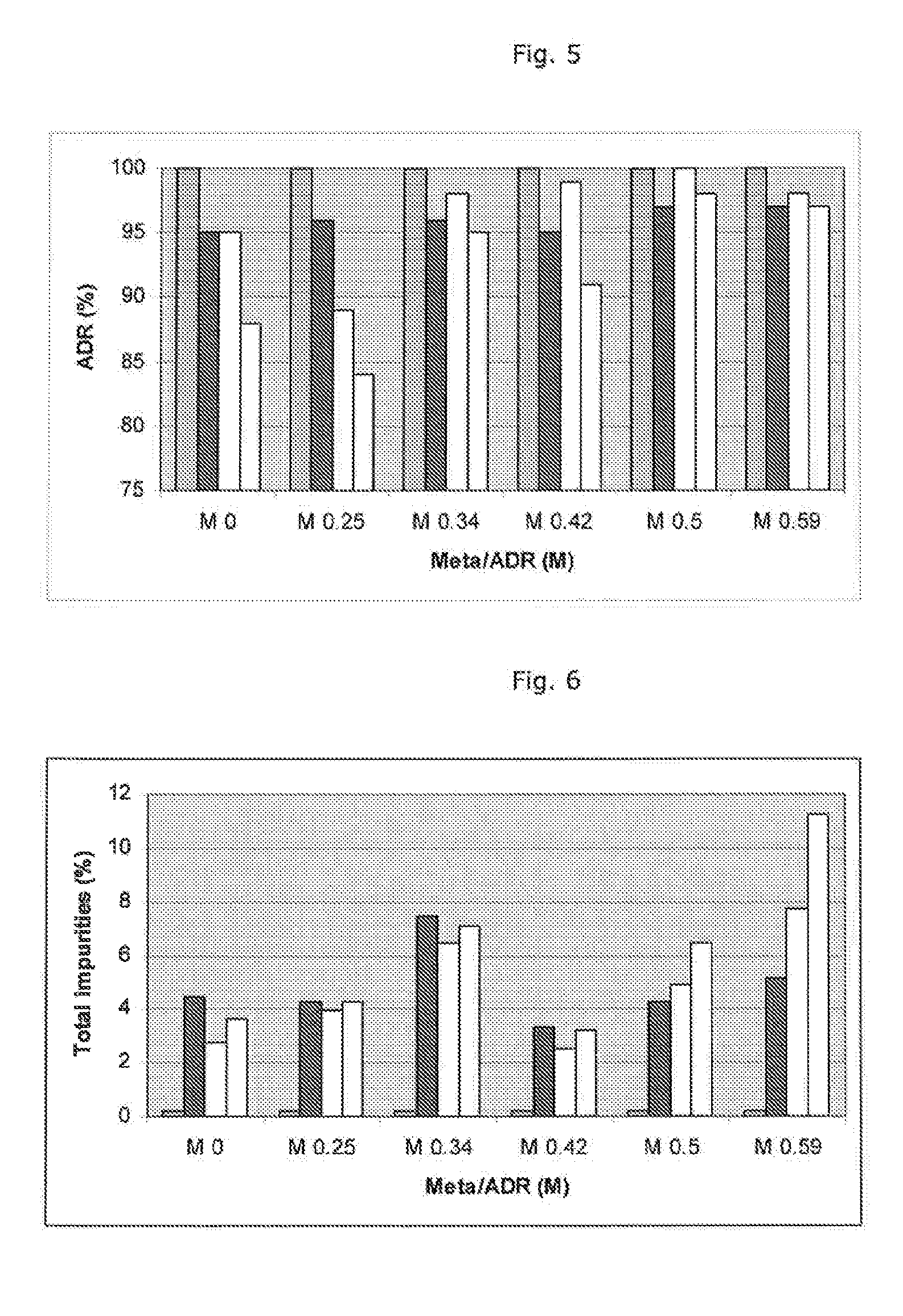Stabilized composition comprising at least one adrenergic compound
a technology of adrenergic compounds and compositions, applied in the direction of drug compositions, inorganic non-active ingredients, immunological disorders, etc., can solve the problems of inability to stabilize compositions,
- Summary
- Abstract
- Description
- Claims
- Application Information
AI Technical Summary
Benefits of technology
Problems solved by technology
Method used
Image
Examples
example 1
[0089]The following formulation was prepared.
IngredientAmount (mg / ml)Epinephrine acid tartrate2.0Sodium chloride6.0Sodium metabisulfite 0.57HCl / NaOHq.s. pH 3.4Water for injectionq.s. 1.0 ml
[0090]Half the final volume of stock solution (1.2% sodium chloride) was pipetted into a glass beaker, the sodium metabisulfite was added and stirred gently to dissolve. Epinephrine acid tartrate was added and the solution stirred gently to dissolve and mix and the pH adjusted, if required, to 3.4±0.2. The solution was made to volume with degassed water for injection and the solution stirred gently for 10 minutes to mix.
example 2
[0091]Stability testing of different ratios of metabisulfite:epinephrine.
[0092]A 1.1 mg / ml solution of adrenaline (6.004×10−3 M), in the form of the tartrate, pH 3.4 and containing 0.6% sodium chloride was used. A range of metabisulfite antioxidant concentrations, with and without admixture of 0.25% di-sodium edetate as chelating agent were tested. The metabisulfite / adrenaline molar ratios tested were 0.1, 0.2, 0.5, 1.0 and 1.5, which correspond to sulfite / adrenaline ratios of 0.2, 0.4, 1.0, 2.0 and 3.0, respectively. For the ease of reference to the general description and claims of this specification, the said values correspond to a molar ratio of adrenaline to sulfite of 5.0, 2.5, 1.0, 0.5 and 0.33, respectively.
[0093]The accelerated test temperature was 60° C., protected from light, and samples were pulled at 0, 7, 14, 21 and 28 days. At each pull point, the appearance of the test solution was assessed, the pH measured and the solution assayed for adrenaline content. The appeara...
example 3
[0101]Further stability testing of different ratios of metabisulfite:epinephrine
[0102]The below tests disclose more information regarding the optimum molar ratio of sodium metabisulfite to adrenaline for stability of the latter.
[0103]The formulation solutions were prepared at a level of 1.0 mg / ml adrenaline (in the form of the tartrate), pH 3.4 containing 0.6% sodium chloride, with various molar ratios (0.25-0.59) of sodium metabisulfite added. The metabisulfite / adrenaline molar ratios tested were 0.25, 0.34, 0.42, 0.5 and 0.59, which correspond to sulfite / adrenaline ratios of 0.5, 0.68, 0.84, 1.0 and 1.18, respectively. For the ease of reference to the general description and claims of this specification, the said values correspond to a molar ratio of adrenaline to sulfite of 2.0, 1.47, 1.19, 1.0 and 0.85, respectively.
[0104]Each sample solution was split into two lots. For each sample solution, one lot was placed at the accelerated test temperature of 60° C., protected from light ...
PUM
| Property | Measurement | Unit |
|---|---|---|
| Density | aaaaa | aaaaa |
| Density | aaaaa | aaaaa |
| Density | aaaaa | aaaaa |
Abstract
Description
Claims
Application Information
 Login to View More
Login to View More - R&D
- Intellectual Property
- Life Sciences
- Materials
- Tech Scout
- Unparalleled Data Quality
- Higher Quality Content
- 60% Fewer Hallucinations
Browse by: Latest US Patents, China's latest patents, Technical Efficacy Thesaurus, Application Domain, Technology Topic, Popular Technical Reports.
© 2025 PatSnap. All rights reserved.Legal|Privacy policy|Modern Slavery Act Transparency Statement|Sitemap|About US| Contact US: help@patsnap.com



